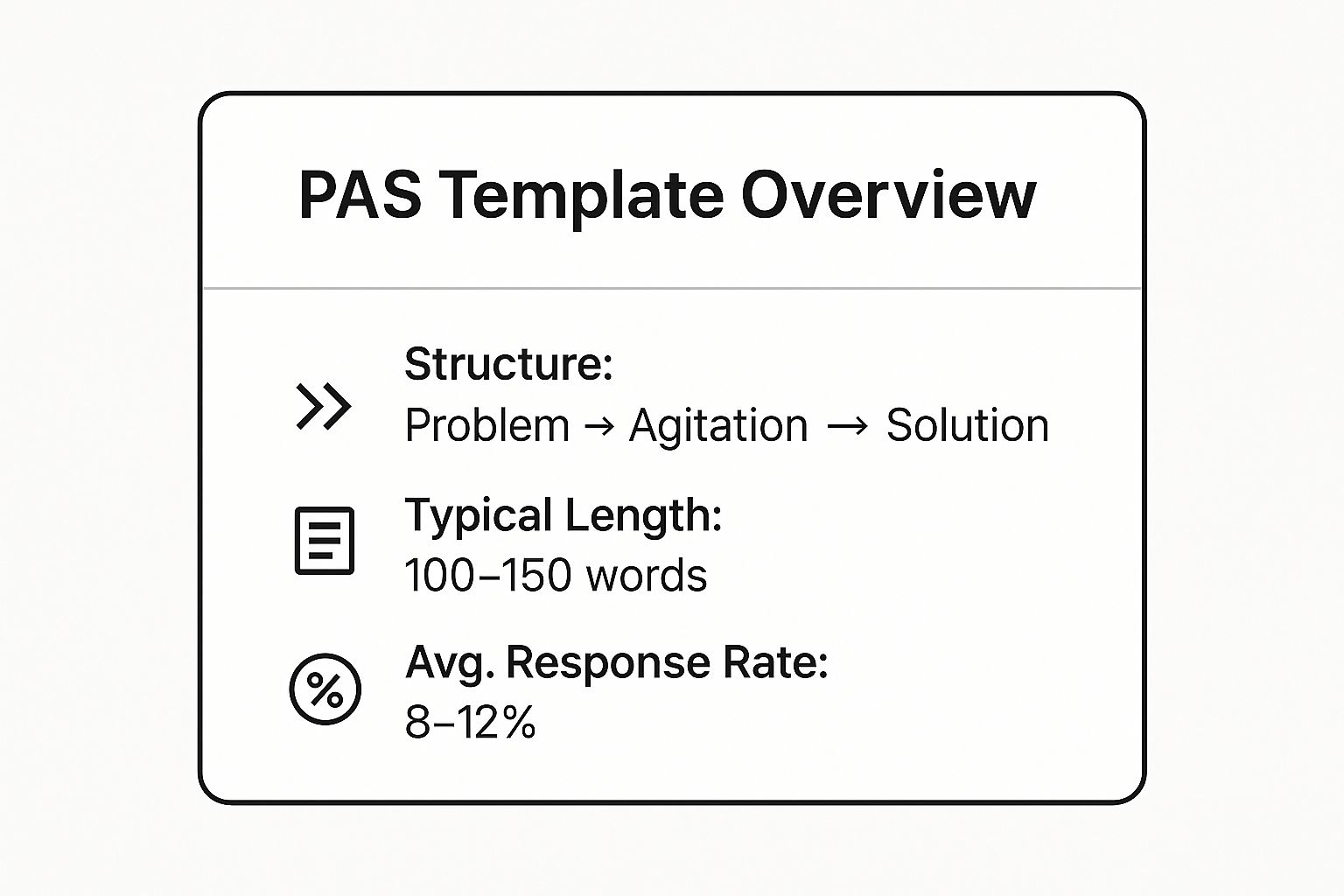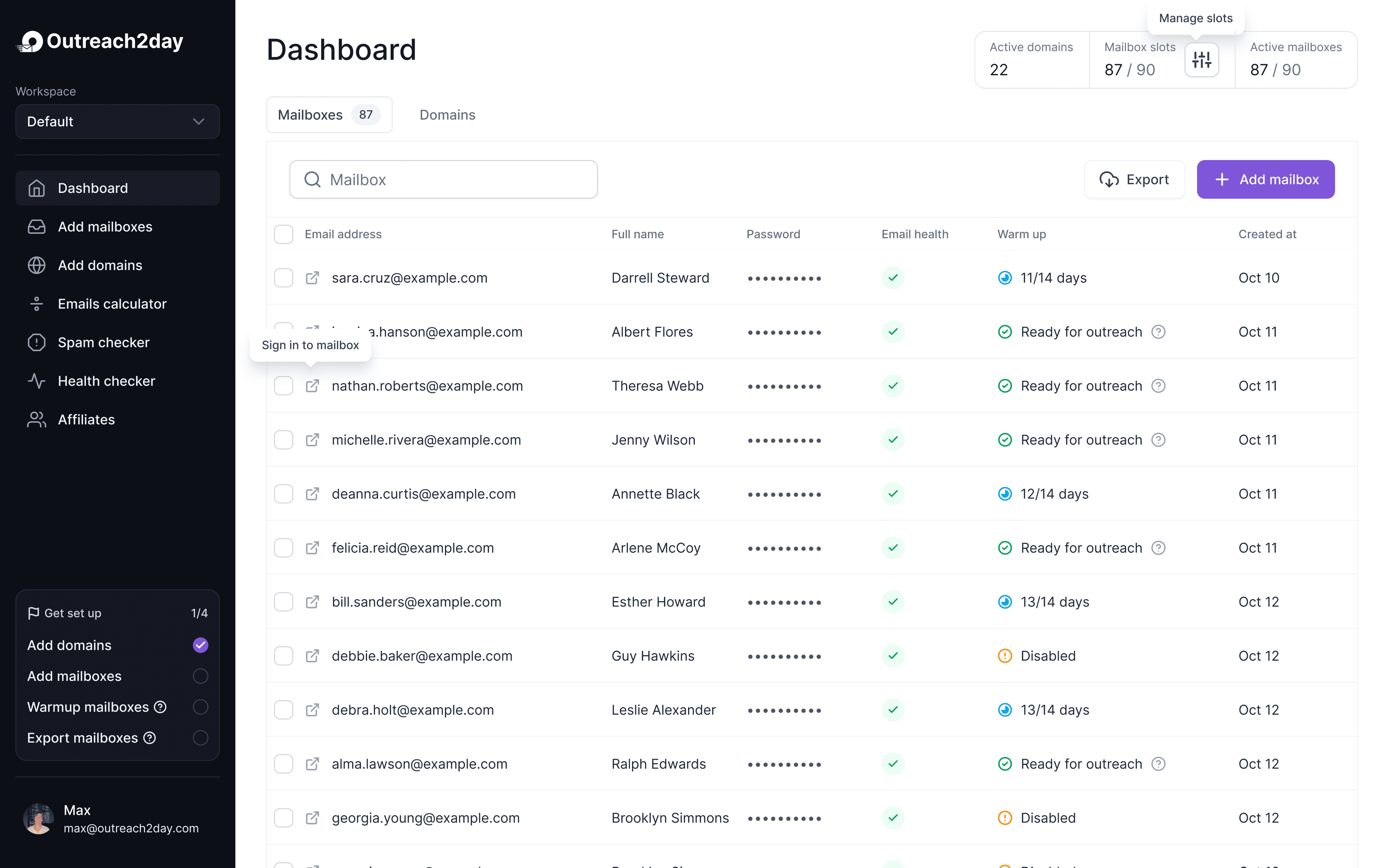Top Cold Email Templates to Boost Your Outreach
Oct 11, 2025

While many view cold emailing as a numbers game, the reality is that strategic structure is what truly drives replies and opens doors. Success isn't found in blasting generic messages; it comes from understanding the psychology behind a compelling outreach. This guide moves beyond basic advice to dissect eight powerful cold email templates, revealing the underlying frameworks and tactical execution that make them effective.
You will receive more than just copy-paste examples. For each template, we will break down the strategic blueprint, explaining why it works and for which specific scenarios it is best suited. We will analyze the core components, from crafting an irresistible subject line to structuring a clear and compelling call-to-action. We’ll explore proven frameworks like Problem-Agitate-Solution (PAS) and Before-After-Bridge (BAB), alongside more nuanced approaches like the Mutual Connection Referral and the Pattern Interrupt.
By the end of this article, you won't just have a collection of cold email templates; you will have a replicable system for crafting persuasive outreach. You will learn how to adapt these structures for your unique audience, whether you're in B2B sales, recruiting, or marketing. This is about building a scalable process for generating meaningful conversations from a cold start.
1. The Problem-Agitate-Solution (PAS) Template
The Problem-Agitate-Solution (PAS) framework is one of the most effective and time-tested cold email templates for a reason: it taps directly into your prospect’s core challenges. This classic direct-response copywriting formula works by first identifying a relevant pain point, then intensifying the negative consequences of that problem, and finally positioning your service as the ideal solution.
This structure immediately demonstrates your understanding of the prospect's world, building rapport before you even mention your offer. It's particularly powerful for B2B sales where business pains like wasted resources, missed opportunities, or operational friction are top of mind. For example, a marketing agency might highlight the high cost of ineffective ad campaigns before offering an audit service that promises better ROI.
Strategic Breakdown
The power of PAS lies in its psychological sequence. By agitating the problem, you create a sense of urgency and make the prospect more receptive to a solution. Without this agitation, a pitch can feel premature or disconnected. The key is to transform a passive awareness of a problem into an active desire for a fix.
Problem: Start with a specific, researched observation about a challenge your prospect likely faces. (e.g., "Noticed you’re hiring for several senior engineering roles, which can be a slow process in today's market.")
Agitate: Briefly expand on the negative impact of that problem. Use metrics or consequences. (e.g., "Empty seats on key projects often lead to delayed product launches and mounting recruitment costs.")
Solution: Introduce your offer as the direct answer to the agitated pain point. (e.g., "Our platform connects you with a pre-vetted pool of senior engineers, reducing time-to-hire by 40%.")
When to Use This Template
The PAS template excels when you can confidently identify a common, high-impact pain point for a specific industry or role. It's ideal for offerings that solve a clear and costly problem, such as cybersecurity solutions preventing data breaches or SaaS tools reducing customer churn. However, its effectiveness hinges on accurate research; a misidentified problem will cause the entire email to fail.
The following infographic provides a quick overview of the PAS framework's key attributes.

As the data suggests, the PAS structure is designed for brevity and impact, yielding a strong response rate when executed correctly. This focus on a singular problem also ensures your email remains highly relevant and avoids getting lost in the inbox. For more insights on ensuring your messages are seen, explore these email deliverability best practices.
2. The Before-After-Bridge (BAB) Template
The Before-After-Bridge (BAB) framework is one of the most compelling cold email templates because it leverages the power of storytelling. This classic copywriting formula works by painting a vivid picture of the prospect's current, challenging reality (Before), then contrasting it with a desirable future state (After). Finally, it introduces your product or service as the essential "Bridge" that connects the two.
This narrative approach helps prospects visualize a tangible, positive outcome, creating a powerful emotional pull toward change. It’s highly effective for services that deliver a clear transformation, such as a content marketing agency showcasing a jump in organic traffic from 5K to 50K monthly visitors or an HR platform reducing time-to-hire from 60 days to 25 days.

Strategic Breakdown
The BAB template’s strength lies in its ability to create desire before presenting the solution. By establishing a relatable "Before" state, you build instant empathy. The "After" state creates aspiration, and your "Bridge" becomes the logical, must-have pathway to achieve it. This structure elegantly sidesteps the common pitfall of leading with product features.
Before: Describe a world the prospect knows well, focusing on a specific frustration or inefficiency. (e.g., "Right now, your sales team likely spends hours each week manually logging calls and updating your CRM.")
After: Paint a picture of a better, more efficient reality. Focus on the outcome, not the process. (e.g., "Imagine if all that data was captured automatically, giving them back 5+ hours a week to focus on closing deals.")
Bridge: Introduce your solution as the straightforward mechanism for achieving that transformation. (e.g., "Our tool integrates with your existing dialer to automate CRM entries, making that a reality.")
When to Use This Template
The BAB template is exceptionally powerful when your solution provides a quantifiable and dramatic improvement. It's perfect for SaaS products, consulting services, and training programs where you can use specific metrics to illustrate the "before" and "after" scenarios. The key to success is personalization; the "Before" state must accurately reflect the prospect's world, which requires solid research. A generic "Before" will make the entire email feel disconnected and irrelevant.
3. The Mutual Connection Referral Template
The Mutual Connection Referral template is one of the most powerful cold email templates because it instantly bypasses the "cold" barrier. By leveraging social proof from a trusted mutual contact, this approach establishes immediate credibility and relevance. It transforms a stranger's email into a warm introduction, dramatically increasing the likelihood of a response.
This framework's effectiveness stems from the principle of association. When a prospect sees a familiar name, their guard drops, and they are more inclined to trust the message's intent. It's an ideal strategy for B2B sales, where relationships and network effects are paramount. For example, a sales rep could mention a shared LinkedIn connection who suggested their software would be a perfect fit for the prospect's company.
Strategic Breakdown
The power of this template is its ability to borrow trust. Instead of building credibility from scratch, you arrive with a pre-vetted endorsement. The key is to make the referral feel authentic and directly relevant to the prospect, not just a shallow name-drop.
Mention Connection: Lead with the mutual contact's name in the opening line or subject line to grab attention immediately. (e.g., "John Smith suggested I reach out.")
Provide Context: Briefly explain the relationship with the mutual contact and why they made the referral. (e.g., "John and I were discussing logistics software, and he mentioned your team is looking to streamline its supply chain.")
Connect to Value: Seamlessly transition to your value proposition, linking it back to the reason for the introduction. (e.g., "We helped his company reduce shipping costs by 15%, and he thought you might see similar results.")
When to Use This Template
The Mutual Connection template is your go-to when you can identify a legitimate, shared connection with a prospect through platforms like LinkedIn. It’s particularly effective in close-knit industries or alumni networks where reputation is currency. Always secure permission from the mutual contact before using their name to maintain professional integrity.
This method excels for securing high-value meetings, partnership opportunities, and roles where a personal endorsement can make all the difference. Misrepresenting the strength of a connection, however, can backfire and damage your reputation, so honesty is crucial for its success.
4. The Value-First Content Template
The Value-First Content template flips the traditional sales pitch on its head by leading with pure, unadulterated value. This strategy prioritizes building trust and authority by offering helpful resources, insights, or tools before ever asking for a meeting. Instead of selling, you’re serving, positioning yourself as a credible expert in the prospect's field.
This approach is rooted in the principle of reciprocity; by providing genuine value upfront, you make prospects more receptive to future conversations. It’s particularly effective for businesses with strong content marketing engines, such as a SaaS company sharing a free industry-specific calculator or a consultant offering a personalized video audit of a prospect’s website. The goal is to be helpful, not just to sell.
Strategic Breakdown
The power of this template lies in its generosity. It immediately lowers the prospect’s guard because the email isn’t asking for anything in return. The focus is on providing a solution to a potential problem without requiring a commitment, which differentiates you from the hundreds of other sales emails in their inbox.
Lead with Ungated Value: Offer a high-quality resource like a report, tool, or video audit without requiring a form fill. (e.g., "I came across your e-commerce site and thought you'd find our latest benchmark report on Q4 conversion rates useful.")
Explain the Relevance: Briefly and specifically connect the resource to the prospect's role, company, or recent activity. (e.g., "Given your focus on expanding into European markets, the section on international payment gateways might be particularly relevant.")
Soft Call-to-Action: The ask should be low-friction and optional, focusing on their potential interest. (e.g., "No action needed, but thought it might be helpful for your team's planning.")
When to Use This Template
The Value-First template is ideal for the first touchpoint in a long-term nurture sequence or when targeting senior-level decision-makers who are often immune to hard pitches. It works best when you have genuinely useful, well-researched content that aligns directly with your prospect’s challenges. It requires patience, as the payoff isn't immediate, but it excels at building a strong foundation for a future sales conversation.
This strategy is a cornerstone of modern outreach, proving that a generous approach can yield significant results. To scale this method effectively without sacrificing quality, consider the logistics of how you would send 100 cold emails a month while maintaining personalization. This template sets the stage for a relationship, making subsequent follow-ups feel more natural and welcome.
5. The Personalized Compliment + Insight Template
The Personalized Compliment + Insight framework is one of the most effective cold email templates because it immediately breaks down the "stranger" barrier. Instead of leading with a generic pitch, it opens with a genuine, specific compliment about a recent achievement by the prospect or their company. This approach proves you’ve done your research and are reaching out with a relevant, timely reason.
This structure works by validating the prospect's hard work before pivoting to a relevant insight or opportunity. The key is to connect their recent success to a new challenge or a way to amplify their results, positioning your offer as a logical next step. For instance, after congratulating a CMO on a successful product launch, a PR agency could offer a strategy to maintain media momentum.

Strategic Breakdown
The power of this template lies in its "give before you ask" psychology. By offering genuine praise and a thoughtful insight, you provide value upfront and earn the right to make a request. The transition from compliment to pitch feels natural rather than forced, making the prospect more receptive to your message. It shifts the dynamic from a cold pitch to a peer-to-peer conversation.
Compliment: Start with a specific, recent, and authentic compliment. (e.g., "Congratulations on your recent Series B funding; scaling your engineering team so effectively is impressive.")
Insight: Connect their achievement to a related opportunity or challenge. (e.g., "Companies at this stage often find that maintaining culture while rapidly hiring becomes the next big hurdle.")
Solution: Introduce your offer as a tool to help them navigate that next step. (e.g., "Our leadership training program is designed specifically for hyper-growth tech firms to solve this.")
When to Use This Template
This template is ideal for targeting high-value prospects where personalization can make or break your outreach. It works best when you can tie a clear, public trigger event (like a funding round, award, product launch, or even a well-written article) directly to your value proposition. Its success depends entirely on the authenticity of the compliment and the relevance of the insight; generic flattery is easily spotted and will backfire. Using tools like Google Alerts and closely following prospects on LinkedIn is essential for timely execution.
6. The Short and Direct Question Template
The Short and Direct Question template is one of the most powerful cold email templates because it leverages brevity and curiosity. This minimalist approach cuts through inbox clutter by asking a highly relevant, thought-provoking question in just a few sentences. It respects the prospect’s time and creates a psychological "open loop," compelling them to consider a response.
This structure’s effectiveness comes from its simplicity. Instead of a lengthy pitch, you immediately engage the prospect on a topic central to their role or business challenges. For example, a growth agency asking, "Are you open to new ways to reduce customer acquisition costs?" saw a 24% response rate by immediately focusing on a key business metric.
Strategic Breakdown
The power of this template is in its directness and relevance. It forces the recipient to think, even for a moment, about a specific challenge or opportunity. A well-crafted question bypasses the typical "sales pitch" filter and initiates a genuine conversation, positioning you as a thoughtful peer rather than just another vendor.
Direct Question: Start with a concise, open-ended question that is directly related to a likely pain point or goal. (e.g., "What's your biggest challenge with new hire onboarding right now?")
Implied Value: The question itself should hint at the value you provide without explicitly stating it. (e.g., Asking about onboarding challenges implies you have a solution for them.)
Clear Call to Action (Implicit): The question serves as the call to action. The goal isn't to book a meeting immediately but to start a dialogue. Your signature provides context on who is asking.
When to Use This Template
The Short and Direct Question template is ideal for outreach to senior executives and busy decision-makers who receive a high volume of emails. It's particularly effective when your research on a company is limited but you can make an educated guess about their priorities based on industry, role, or recent company news. It works best for offerings that are easy to connect to a specific business problem.
However, success depends entirely on the quality of the question. It must be specific, relevant, and not easily answerable with a simple yes or no. Before sending, ensure your email infrastructure is properly set up; you can find support with the best email warm-up tools to maximize deliverability and ensure your question gets seen.
7. The Case Study Story Template
The Case Study Story template leverages the power of social proof and narrative to make your solution feel tangible and credible. Instead of just describing what you do, this approach tells a compelling story about how you helped a similar client achieve measurable results. It’s one of the most effective cold email templates because it allows the prospect to see a clear path to success by identifying with a past client's journey.
This framework shifts the focus from your product's features to the prospect's potential outcomes. By presenting a relatable client who faced similar challenges, you build instant rapport and demonstrate your expertise in a real-world context. For instance, a software company might share a brief story of how a direct competitor saved 15 hours per week, immediately framing the value proposition in terms the prospect understands.
Strategic Breakdown
The strength of this template lies in its narrative arc, which is more engaging than a simple feature list. It transforms a cold pitch into a mini-success story, making your claims more believable and your solution more desirable. The key is to connect the dots between a familiar problem and a specific, impressive result.
Relatable Hero: Introduce a client who mirrors the prospect’s profile. (e.g., "I'm reaching out because we recently worked with another mid-sized SaaS firm…")
Conflict & Resolution: Briefly state the challenge they faced and the solution you provided. (e.g., "...that was struggling to reduce customer churn. We implemented our onboarding automation sequence…")
Measurable Victory: Conclude with a clear, quantifiable outcome. (e.g., "...which cut their churn rate by 22% in the first quarter.")
When to Use This Template
The Case Study Story is perfect when you have strong, metric-driven results from a client who closely resembles your target prospect. It excels in industries where proof of performance is critical, such as marketing, consulting, and enterprise software. This method is particularly powerful for building trust and overcoming skepticism with high-value prospects.
Remember to get permission before using a client’s name. If that isn't possible, an anonymized description like "a leading e-commerce brand in the fashion space" works just as well. The focus should always be on the relatable challenge and the impressive, data-backed result.
8. The Pattern Interrupt / Creative Approach Template
The Pattern Interrupt template deliberately breaks conventional cold email norms to capture attention through creativity, humor, or an unexpected angle. This approach disrupts the recipient's routine of deleting predictable sales pitches by using unusual subject lines, self-aware humor, or surprising formats. The core goal is to create a memorable moment that compels the prospect to read on.
This strategy stands out in a crowded inbox by being different. Instead of leading with a standard value proposition, it leads with personality, making the email feel less like an automated script and more like a message from a real person. For instance, a startup might send an email with the subject line "This is awkward..." to playfully acknowledge the unsolicited nature of the outreach, immediately disarming the prospect.
Strategic Breakdown
The power of a pattern interrupt lies in its ability to bypass the recipient's automatic "sales email" filter. By being unpredictable, you earn a few extra seconds of attention, which can be enough to communicate your core message. The key is to ensure the creative hook transitions smoothly into your value proposition without feeling disjointed.
Interrupt the Pattern: Start with an element that is completely unexpected. (e.g., "I'm breaking up with you..." as a final follow-up, or using tasteful ASCII art in a plain text email.)
Acknowledge and Pivot: Briefly explain the creative approach and connect it directly to your reason for reaching out. (e.g., "Okay, not really breaking up, but since I haven't heard back, I assume this isn't a priority right now.")
State Your Value: After capturing their attention, deliver a concise, clear pitch or call-to-action. (e.g., "If improving your team's project workflow becomes a priority again, our tool can help.")
When to Use This Template
The Pattern Interrupt is one of the more high-risk, high-reward cold email templates. It works best when targeting industries that appreciate creativity, such as marketing, tech, or media. It’s also highly effective for final follow-up emails where you have nothing to lose. However, its success is heavily dependent on audience and execution; a creative joke that lands well with a startup founder may fall flat with a C-suite executive at a traditional financial firm. Use this approach when you have a strong understanding of your prospect’s company culture and want to make a bold impression.
Cold Email Template Comparison Guide
Template | Implementation Complexity 🔄 | Resource Requirements 💡 | Expected Outcomes 📊 | Ideal Use Cases 💡 | Key Advantages ⭐ |
|---|---|---|---|---|---|
Problem-Agitate-Solution (PAS) | Medium - requires deep research for pain points; time-intensive customization | High - thorough prospect and industry research needed | Moderate response (8-12%); drives urgency and engagement | B2B sales, consulting, industries with clear pain points | High engagement; builds credibility; empathetic connection |
Before-After-Bridge (BAB) | Medium - narrative crafting and credible proof needed | Medium - needs measurable data and case support | Higher response (10-15%); visualizes positive transformation | Product launches, measurable outcomes, visualization-driven decisions | Easy value understanding; less aggressive; memorable format |
Mutual Connection Referral | Low to Medium - needs genuine connections and permissions | High - requires network leverage and relationship management | Very high response (25-40%); builds instant trust | High-value enterprise sales, competitive bidding, strategic relationships | Trust transfer; higher open/response; bypasses skepticism |
Value-First Content | Medium - requires high-quality relevant content | High - content creation and curation investment | Moderate engagement (12-18%); slower sales cycle | Complex B2B, thought leadership, trust-critical industries | Builds trust; positions as expert; lowers resistance |
Personalized Compliment + Insight | High - very time-intensive research per prospect | Very high - research and writing skill intensive | High response (18-25%); stands out by personalization | Executive-level outreach, high-value prospects, competitive environments | Genuine personalization; emotional positive response; credibility |
Short and Direct Question | Low - extremely brief, minimal context | Low - minimal research, fast to craft | Moderate response (15-22%); quick curiosity-driven replies | High-volume outreach, fast-paced industries, inbox-heavy prospects | Respects time; stands out; easy A/B testing; mobile-friendly |
Case Study Story | Medium to High - needs proven case studies and permission | Medium - preparation of stories and metrics | Moderate to high response (14-19%); social proof driven | Agencies, B2B SaaS, result-focused services | Concrete proof; storytelling engagement; credibility boost |
Pattern Interrupt / Creative | High - risky and needs creativity with precision | High - creative development, testing, and refinement | Highly variable (5-35%); can be viral or damaging | Innovative companies, creative industries, hard-to-reach execs, final follow-ups | High memorability; breaks noise; emotional engagement |
From Template to Pipeline: Activating Your Cold Email Strategy
Throughout this guide, we've deconstructed eight powerful cold email templates, moving far beyond simple copy-and-paste examples. From the psychological precision of the Problem-Agitate-Solution (PAS) framework to the directness of the Short Question template, the goal was to equip you with a strategic arsenal, not just a list of scripts. Each template serves as a blueprint for a specific outreach scenario, designed to be adapted, personalized, and deployed with intent.
The central theme connecting all these examples is that a template is merely a starting point. Its true power is unlocked only when combined with deep prospect research and genuine personalization. A generic compliment is easily ignored, but a specific insight into a recent project or a shared challenge immediately signals that you've done your homework. This is the critical shift from mass blasting to targeted, one-to-one communication at scale.
The Real Secret to Success: Beyond the Template
However, even the most meticulously researched and brilliantly written email is destined for failure if it never reaches the inbox. This is the unspoken truth of cold outreach: technical deliverability is the foundation of your entire strategy. Without a solid technical setup, your creative efforts are wasted.
Mastering the following technical elements is not optional; it is essential for anyone serious about cold email:
Domain Authentication: Properly configuring SPF, DKIM, and DMARC records is non-negotiable. These act as your digital passport, verifying to email providers that you are a legitimate sender.
Inbox Warm-Up: Just like an athlete, a new email account needs to warm up before it can perform. Gradually increasing sending volume builds a positive sender reputation, which is crucial for avoiding spam filters.
Volume and Cadence Management: Sending too many emails too quickly from a single inbox is a red flag for spam filters. A disciplined approach to volume and timing is key to long-term success.
These technical hurdles often become the biggest bottleneck for sales and growth teams. The time and expertise required to manage dozens of domains and inboxes can divert focus from the high-value work of crafting compelling messages and building relationships. Choosing the right cold email templates is only half the battle; ensuring they land in the primary inbox is the other, more technical half.
Ultimately, the journey from template to pipeline is one of strategic integration. It requires marrying the art of persuasive writing with the science of email deliverability. When you combine a powerful, personalized message with a technically sound infrastructure, you create a repeatable system for turning cold prospects into warm conversations and, eventually, valuable customers.
Ready to stop worrying about deliverability and start focusing on closing deals? Outreach Today automates the entire technical setup, providing you with dozens of pre-warmed, high-deliverability inboxes in minutes. Transform these powerful cold email templates into a predictable revenue pipeline by visiting Outreach Today and launching your next campaign with confidence.
Setup your outreach in
3 minutes. Literally.
Add or transfer domains from other platforms, set up mailboxes, and initiate warming or export processes

